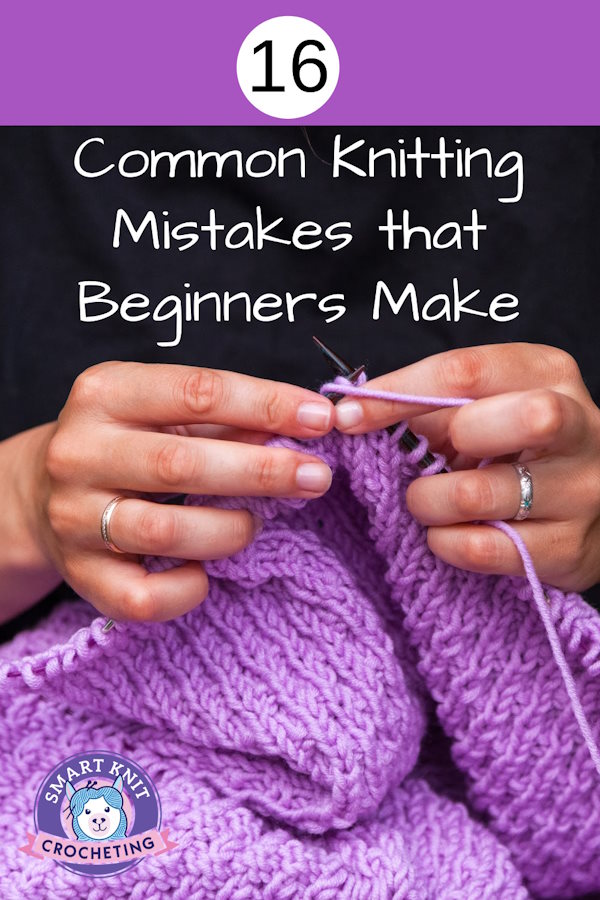- Home
- How to Knit: Basics
- Knitting Mistakes Beginners Make
16 Knitting Mistakes Beginners Make: How to Fix Them
Knitting Mistakes for Beginners
By Janice Jones, Certified Knitting Instructor
Last updated: September 2025
So you decided to take up knitting, perhaps because your friend offered to teach you, or you thought it might add a new craft to your repertoire, or maybe you heard it was a healthy, mindful, and productive way to fill your free time.
Knitting is an excellent craft that allows you to create beautiful and functional items using just two needles and yarn.
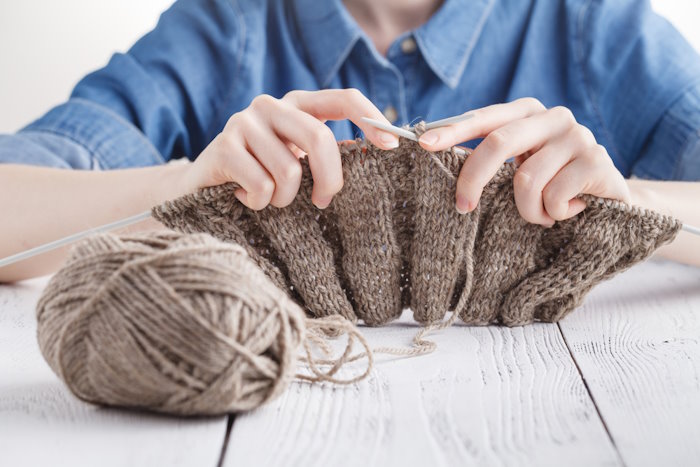
If you are a beginner or have some experience, knowing that you are not alone is essential. We all started just where you are now. As beginners, we all have one thing in common: we all make mistakes. I can personally attest that I have made my fair share of mistakes over the years.
In this article, I will share some of my mistakes and what I've heard from others. Better still, I will provide tips to help you avoid or correct those
common knitting mistakes altogether.
By the end of this article, you'll have the knowledge and confidence to embark on your knitting projects with ease.
Common Mistakes to Avoid as a New Beginner Knitter
These common beginner knitter mistakes are very common, so don't be too hard on yourself. Luckily, all mistakes are fixable or avoidable, so check out these 16 mistakes. (Remember, we all make mistakes.)
1. Avoid Dropped Stitches
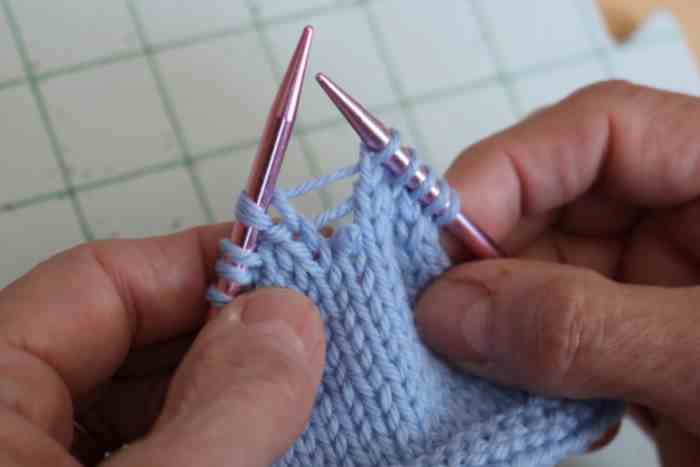 Avoid Dropped Stitches
Avoid Dropped StitchesThe Problem: A hole appears in your fabric, and your stitch count is off.
Why It Happens: Needle slips off a stitch unnoticed, especially in loose knitting.
Quick Fix: Use a crochet hook to ladder the stitch back up. Place stitch markers to help track sections. Count stitches at the end of every row.
Key Takeaway: Catch dropped stitches early; they’re easy to fix when spotted quickly.
This is likely the most common knitting mistake that occurs when new knitters start making fabric. Dropped stitches are a common knitting mishap that can be easily avoided with a bit of attention to detail.
A dropped stitch occurs when a stitch slips off the needle and unravels down the work, often without being conscious of dropping the stitch.
To prevent this, periodically count the stitches on your needle. If you cast on 25 stitches and now only have 23 stitches, you most likely lost some stitches somewhere.
Examine the fabric you created to identify where you lost these two stitches. Look for loose stitches or holes. Look for places where a stitch may have been dropped.
They resemble little ladders that begin at the needle and extend down into the fabric. Learn how to pick up dropped stitches using a crochet hook when you notice them.
Learn how to fix dropped stitches.
2. Knitting in the Wrong Direction
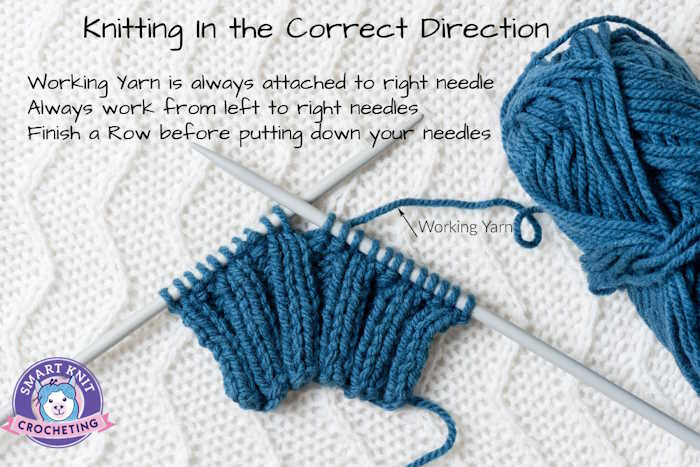 Other knitting mistakes beginners make include getting confused about which direction to work.
Other knitting mistakes beginners make include getting confused about which direction to work.The Problem: Row Counts and Fabric Uneven
Why It Happens: Picking up knitting after a recess and beginning to knit in the wrong direction
Quick Fix: Always check that the working yarn is attached to the stitches on the right needle.
Key Takeaway: Finish knitting to the end of the row before taking a break, or ensure that your working yarn is attached to the right needle.
This may seem silly, but it is far too common among new knitters just starting. This mistake is easier to avoid but not impossible to correct.
To avoid this mistake:
Always finish the row before you put your needles down. In other words, do not stop in the middle of the row.
If you must stop in the middle of the row, look at your needles when you begin again. The working yarn should be attached to the right-hand needle.
To correct this mistake:
You must rip out the rows that you knit in the wrong direction. Place the ripped stitches back on your needle and continue.
3. Uneven Stitches
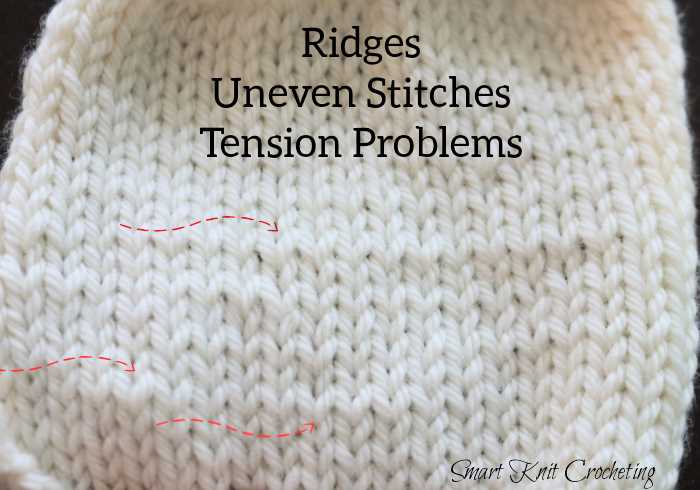
The Problem: Rows and Stitches are uneven
Why It Happens: Tension is the problem. Some stitches are worked more tightly or loosely than others.
Quick Fix: Learn to adjust your tension so your stitches are worked evenly.
Key Takeaway: Attention to detail and practice usually solve this problem.
This is one of those common beginning knitting errors that can only be fixed with practice. The overall effect is not pleasing when some stitches are more prominent than others. This happens because we haven't mastered tension.
Some knitters will hide this problem by using variegated or specialty yarns that make it difficult to see individual stitches. That doesn't solve the problem, though.
Uneven stitches can occur anywhere, but are most noticeable in several places.
- Edge (selvage) stitches are often uneven if the tension is not quite right.
- You may also notice this problem between knit and purl stitches when knitting ribbing or cables.
- Another place where uneven stitches occur is between knit and purl rows. This is due to the tension difference between knitting purls and knits. For example, your knit stitches may be tighter than your purl stitches.
This takes practice, but I recommend reading my article about tension and how to fix this mistake.
4. Twisted Stitches
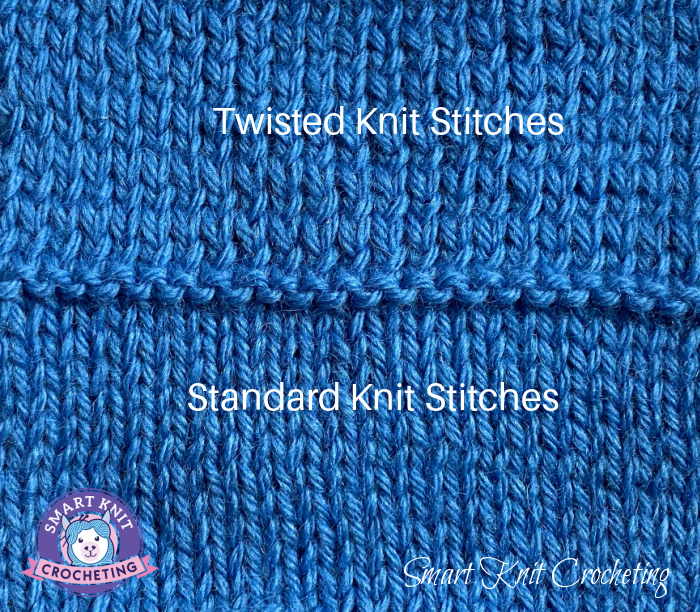 Some knitting mistakes beginners make involve how stitches rest on the needles.
Some knitting mistakes beginners make involve how stitches rest on the needles.Twisted Stitches
The Problem: Fabric looks uneven or twisted; patterns don’t line up.
Why It Happens: Stitch mounted backward on the needle, or wrong entry into the loop.
Quick Fix: Always check stitch “legs”—the leading leg should face forward. Insert your needle consistently (through the front leg for standard knitting).
Key Takeaway: Watch stitch orientation—fixing twists is simple once you know what to look for.
Unless you deliberately try to create twisted stitches, you will want to avoid them so the fabric you create will be uniform and beautiful. Twisted stitches commonly occur because you are doing one of two things:
1. The stitches on your needles are not placed correctly. This often happens if you must ripe out some stitches and put the stitches back on the needle incorrectly.
2. You knit the stitches incorrectly.
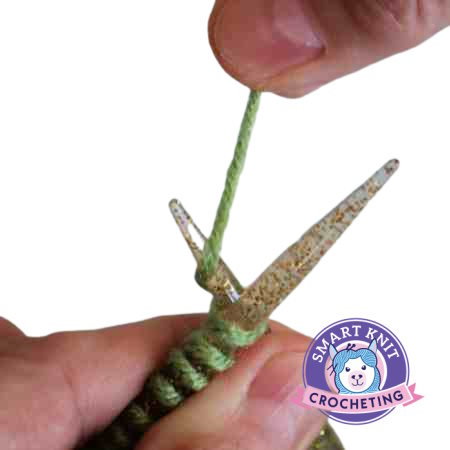 Wrapping your yarn properly, as shown here, will help prevent twisted stitches.
Wrapping your yarn properly, as shown here, will help prevent twisted stitches.Learn more about Twisted Stitches
5. Finding Holes in Your Work
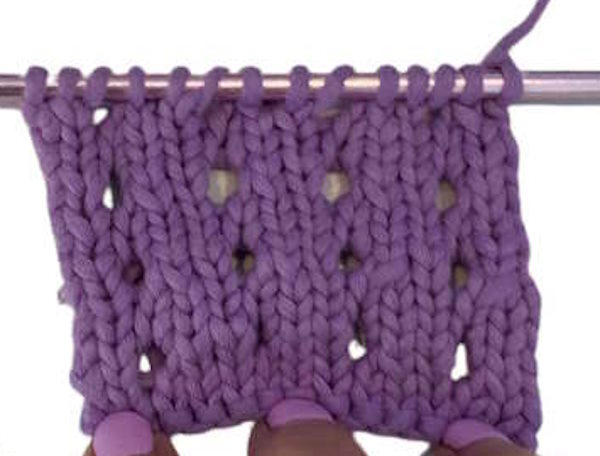
Assuming you do not want holes in your work, the likely cause of this problem is accidental yarnovers or dropped stitches. There is nothing wrong with yarnovers, a technique used in lace work to create holes.
But if you knit a patch of stockinette stitches and notice a hole, it is likely a knitting error. You must first recognize the hole as a mistake to correct this issue.
It's a good idea to place a stitch marker next to the hole to mark it. Secondly, you must rip your stitches back to the hole's location. Remove the yarn, place all the stitches back on the needle, and re-knit.
6. Casting on and Binding off Mistakes
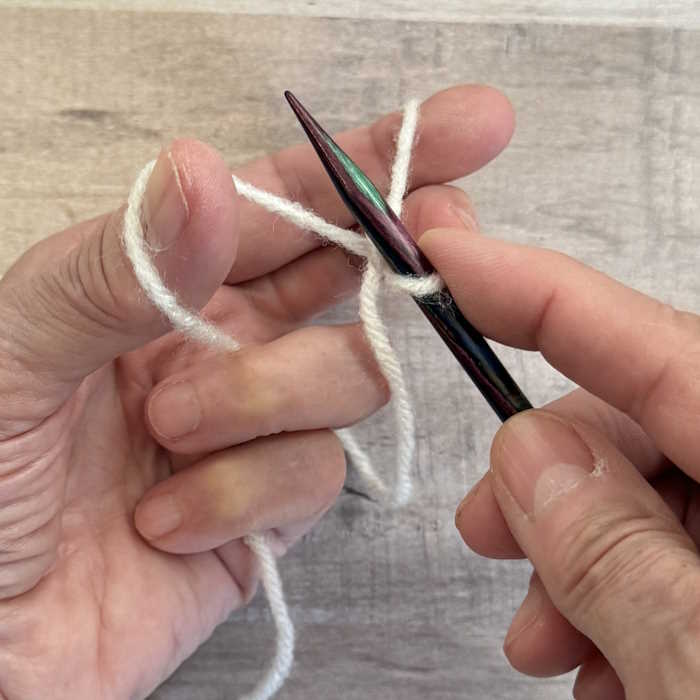
Typically tension is often the problem when casting on or binding off. You can either cast on too tightly or loosely.
Similarily, when binding off, we can either bind off too tightly or too loosely.
Casting On
If you cast it on too tightly, the edge will curl into a frown. If the cast on the edge is too loose, the stitches look sloppy. If this happens to you, the most straightforward remedy is to use a different-sized needle for casting on. Use one needle size larger if your cast-on is too tight and one smaller if your cast-on is too loose. There are also many ways to cast on, so a different cast on method, might correct the mistake.
Binding Off
The same holds for binding off. Adjust your needle size up or down so that your cast-on and bind-off edges are straight and parallel. Even blocking may not be able to correct these problems.
Learn how to cast on stitches.
Learn how to bind off stitches.
7. Putting Stitches on the Needle Backwards
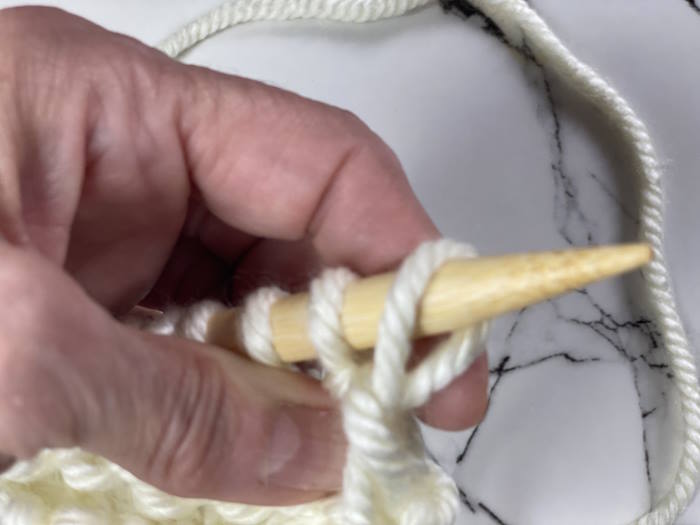
If you cast on all your stitches using standard cast-on methods, your stitches will face the correct direction.
When viewing the stitches on the needles, there are two legs, one is on the far side of the needle, and the other leg is on the side closest to you.
If you look closely, you will see that one leg is closest to the needle point and one is not. If they are placed correctly, the leg closest to you should also be closest to the needle tips. This is how the stitches should rest on the needle if they are accidentally dropped.
8. Knitting Mistakes Beginners Make: Adding a Stitch, Unintentionally
Like losing stitches, adding stitches somewhere along the row will make your stitch count incorrect. Counting stitches at the end of every row is essential to ensure your count remains consistent.
If you end up with an extra stitch, you likely added one somewhere in that row. These accidental yarnovers can produce a new stitch.
The easiest way to avoid this is to concentrate on knitting stitches only and not picking up parts of a stitch to work. If this happens to you, the next step is to rip back to a row where the correct stitch count exists.
Pick up and place those stitches back on the needle and continue.
9. Wrong Choice of Needles or Yarn
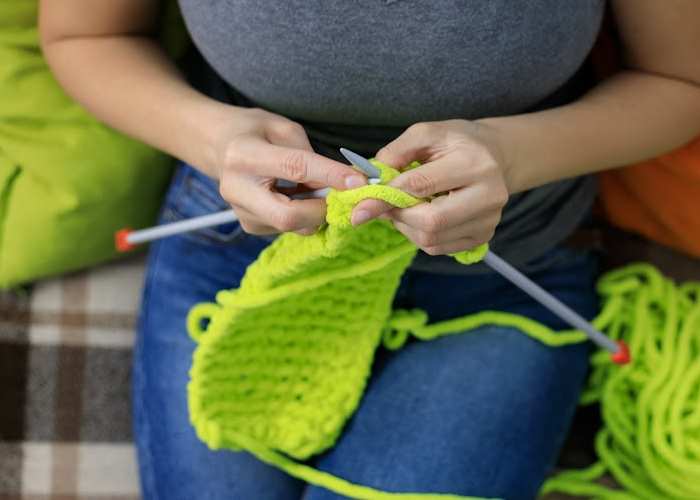 This is likely not a knitting mistake beginners make, but it's worth noting that knowledge of yarn and needles is a good skill to develop.
This is likely not a knitting mistake beginners make, but it's worth noting that knowledge of yarn and needles is a good skill to develop.Using the Wrong Needles
The Problem: Stitches slip off or feel too tight; controlling tension is difficult.
Why It Happens: Needle size or material mismatched to the yarn or your preferences.
Quick Fix: Try different needle materials (metal, bamboo, plastic) until you find one that feels comfortable. Use the size needle recommended on the yarn ball.
Key Takeaway: The right tools make learning more efficient and smoother.
Another common mistake is using the wrong needles and yarn for your project. The size of your needles and the weight of your yarn should match the requirements stated in your pattern.
Using the wrong size can impact your gauge, resulting in a finished piece that is too large or too small. Always check the recommended needle size and yarn weight against both the pattern and the yarn label before starting a new project.
Suitable knitting needles and yarn are essential for a successful knitting project. Knitting needles are available in various materials, including metal, wood, and plastic.
Each material has its characteristics, so it's essential to experiment and find what works best for you. Additionally, different projects may require different needle lengths and sizes. Longer needles are ideal for larger projects, while shorter needles are more suitable for smaller items, such as socks or hats.
When it comes to yarn, countless options are available, each with its unique texture, weight, and fiber content. Consider the type of project you're working on and choose a yarn that complements it. The Craft Yarn Council offers valuable information on needle sizes and how to pair them with yarn weights.
For example, a soft and cozy yarn is perfect for a winter sweater, while a lightweight and breathable yarn is better suited for a summer top. Remember to check the yarn label for recommended needle size and gauge information.
Learn more about knitting needles.
Learn more about Yarn.
10. Common Knitting Mistakes Beginners Make: Not Understanding Charts or Patterns
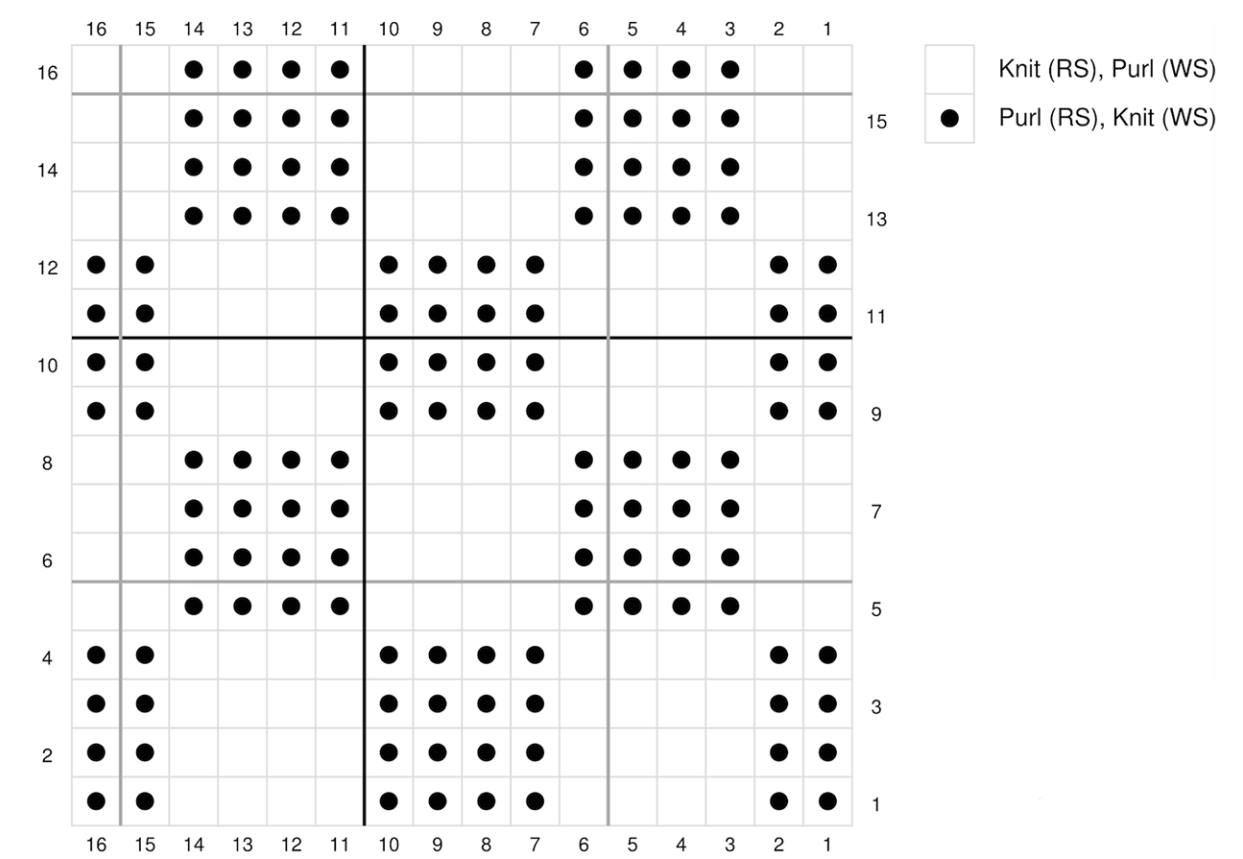
Knitting patterns can seem intimidating initially, but you can easily decipher them with some practice. Start by reading my articles on knitting instructions, knitted charts, and knit abbreviations and symbols.
Once you are ready for your first project using a pattern, start by reading the pattern instructions thoroughly before you begin. Pay attention to any abbreviations or special stitches used. Download my knitting glossary and keep it handy for reference. Highlight any abbreviations to review.
Charts are another common element in knitting patterns. They visually represent the stitches and can be especially useful for complex patterns or lacework.
Learn to read charts by following the symbols and understanding their meanings. Practice with more detailed charts before taking on more intricate designs. If charts are intimidating at this stage, stick with the written instructions and master those before moving on to charts.
Understanding how to Read Patterns and Charts
11. Not Weaving in Ends Properly.
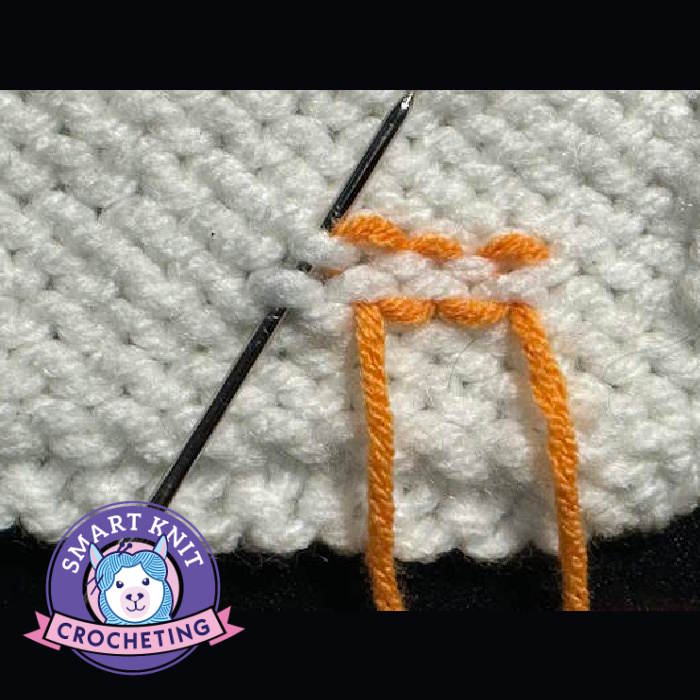
The Problem: Projects unravel or look messy on the wrong side.
Why It Happens: Loose tails cut short or not woven securely.
Quick Fix: Leave at least 6 inches (15 cm) of tail when casting on. Use those six inches to weave in the ends.
Key Takeaway: Proper finishing makes your project last and look professional.
There is more than one way to weave in ends, but be sure to weave them in securely so that they do not unravel, which can leave holes in your finished project. Learn more about weaving in ends.
This is a skill that requires practice to execute correctly, ensuring the ends do not show on the right side of the fabric.
Learn how to weave in those ends.
12. Forgetting to Block Your Work
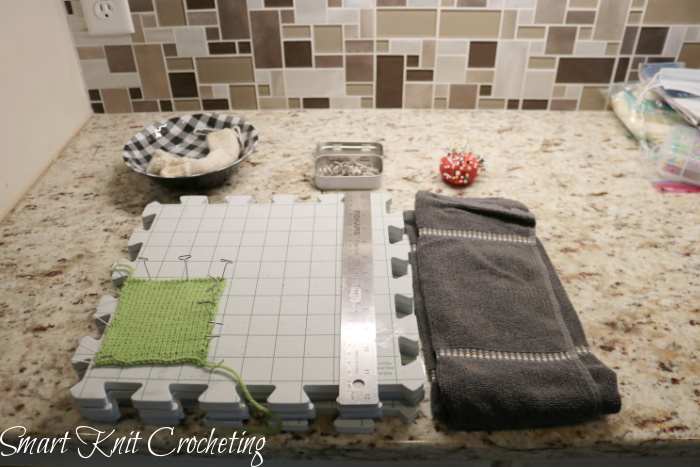
Blocking is essential in finishing your knitting projects and giving them a polished look. Blocking involves wetting your finished piece and shaping it to the desired dimensions. This process evens out your stitches and helps your project retain its shape.
To block your knitting, immerse it in lukewarm water with a gentle wool wash. Gently squeeze the excess water, then lay your knitting flat on a clean towel. Use rust-proof pins or blocking wires to shape and let it dry completely.
Once your project is dry, you can proceed with the finishing touches. This may include weaving in loose ends, sewing on buttons, or attaching embellishments.
Take your time to complete these final steps with care, as they contribute to your knitted item's overall appearance and durability.
Learn more about Blocking Your Work
13. Not Making a Gauge Swatch

Tension and gauge are crucial aspects of knitting that can make or break your project.
Tension refers to how you hold your yarn and control the tightness of your stitches. Consistent tension ensures that your stitches are uniform and your finished piece looks professional.
Practice finding the proper tension for you by experimenting with different yarns and needles and how you hold your yarn.
Conversely, Gauge is the number of stitches and rows per inch in your knitting.
It helps you determine the size of your finished piece and whether it matches the pattern's requirements. Not all projects rely on a specific gauge, such as placemats, washcloths, or scarves, but if you attempt to make something that you hope will fit, the Gauge is critical.
To measure the Gauge, knit a swatch using the recommended needle size and yarn weight specified in your pattern. Count the number of stitches and rows within a 4x4 inch square and compare it to the pattern's Gauge. Adjust your needle size accordingly to achieve the correct Gauge.
Learn more about knitting gauge.
14. Losing Track of Where You Are
This can happen to anyone, beginner, intermediate or advanced knitter. As we advance from super simple to more complete stitch patterns, we may lose track of our progress.
This happens when we graduate from a two- or four-row repeat pattern to an eight- or 12-row pattern. How do you keep track of your progress?
There are several ways to avoid getting into trouble and losing your place.
- Use stitch markers to keep track of the row you are knitting.
- Use a row counter to tell you what row you are knitting.
- Use paper and pencil methods like tally marks to follow your progress.
- Use an online pattern program.
If you lose your place, learn how to read your stitches, bringing us to number 15.
15. Not Understanding How to Read Your Stitches
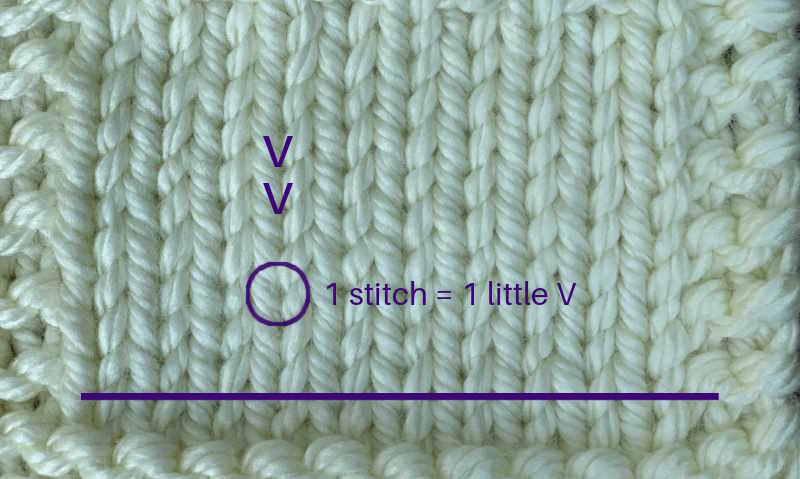
New Knitters will likely master stitch patterns such as garter, stockinette, rib, or seed stitch. As we learn a new stitch pattern, we must also understand what the stitches look like.
It may also be challenging to determine whether we've made any mistakes if we fail to recognize a knit from a purl. Worse yet, we may acknowledge that something looks wrong, but we can't determine where or how to fix it.
16. Knitting Mistakes Beginners Make: Not Understanding Yarn Labels
There is a lot of helpful information on yarn labels that can be used to make decisions.
- What needle size to use.
- How much yarn to purchase.
- How will I launder projects made with this yarn? Is this a practical method for me?
- Is this fiber appropriate for the item I wish to create?
- Do I understand the type of fiber I will be using, and do I have experience with it?
- Will I be able to create a gauge Swatch that matches the yarn weight and needle size, or will I need to make other compensations?
Learn more about reading yarn labels
Knitting Mistakes Beginners Make: Conclusion
Knitting is a rewarding and versatile craft that offers endless possibilities for creativity. By avoiding common mistakes, choosing suitable materials, understanding patterns, and practicing proper tension, you'll be well on your way to becoming a confident and skilled knitter.
Remember, knitting is a journey of learning and exploration, and an inevitable part of knitting is making mistakes, so embrace the process.
Don't be afraid to make mistakes – they are part of learning.
Here I have a little confession to make.
I'm a perfectionist.
I've been that way forever, and I have struggled my entire life to overcome my perfectionist tendencies.
Knitting, more than anything else, has helped me realize that I don't need to be perfect. Yes, if you are trying to be a master knitter, you might need to knit to perfection, but for the rest of us, relax and enjoy the process.
FAQ: Common Knitting Mistakes (and Quick Fixes)
Why do my stitches look uneven?
Why do my stitches look uneven?
Uneven stitches usually come from inconsistent tension. Practice relaxing your grip, keep the yarn flowing in the same direction each row, and try a needle material that slows or speeds up your yarn to match your style. Practice both English and Continental Knitting to see which method works better for you. See: Tension tips
How can I fix a dropped stitch without having to start over?
How can I fix a dropped stitch without having to start over?
Use a crochet hook to ladder the stitch back up to the needle, matching knit or purl “legs” as you go. Secure it, then count your stitches to confirm you’re back on track. Assure that all stitches are placed in the right direction on the needle. Here is an article that can provide more information about dropped stitches.
What causes holes in my knitting?
What causes holes in my knitting?
Accidental yarnovers or dropped stitches are the usual culprits. If you spot a hole, place a marker, rip back carefully to the problem row, and re-knit, avoiding extra wraps. Learn more about dropped stitches or yarn overs in knitting.
How can I stop twisting my stitches?
How can I stop twisting my stitches?
Ensure each stitch sits on the needle with the leading leg forward (closest to the needle tip), and insert the needle in the same manner every time. If you rip back, re-mount stitches correctly. Details: /twisted-stitch.html
Why doesn’t my project fit even though I followed the pattern?
Why doesn’t my project fit even though I followed the pattern?
Your gauge is not the same as the designer's. Make a gauge swatch at least 4 inches square. Calculate your gauge and match it to the gauge indicated in the pattern. If it does not match, change the needles to match the gauge. Skipping the swatch is the fastest route to sizing woes. Learn more about gauge swatches.
I lose track of my row—any easy tricks?
I lose track of my row—any easy tricks?
Use locking stitch markers, a row counter, tally marks, or a simple app to keep track of your progress. Place markers at repeats and add a removable marker at the active row so you can resume confidently. Use a metallic pattern holder and ruler to help you keep track of the row you are knitting.
I’m confused by charts and abbreviations—where should I start?
I’m confused by charts and abbreviations—where should I start?
The vast number of abbreviations used in knitting can be overwhelming for beginners. Start with the legend provided with the pattern, but don't feel obligated to memorize all the abbreviations. You will remember them as you continue to knit. Use our downloadable abbreviations chart that you can print and keep handy in your knitting bag. Start by learning how to read charts on this website for guidance on understanding them.
What info on a yarn label actually matters?
What info on a yarn label actually matters?
Look at the fiber content and how that fiber should be laundered. Look for the weight category, either written as a number or a description. Find the recommended needle size and gauge. If you are substituting yarns, check the yardage as each ball holds a different length of yarn. My Yarn Label article will provide more information.
12) What info on a yarn label actually matters?
Check fiber content (feel/care), weight category, recommended needle size, gauge, yardage, and care symbols. These determine fit, drape, and maintenance. Quick guide: /yarn-labels.html
